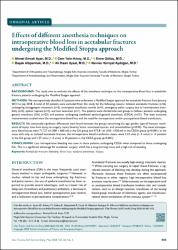Effects of different anesthesia techniques on intraoperative blood loss in acetabular fractures undergoing the Modified Stoppa approach

Göster/
Tarih
2020Yazar
Açan, Ahmet EmrahKılınç, Cem Yalin
Gültaç, Emre
Altıparmak, Başak
Uysal, Ali Ihsan
Aydoğan, Nevres Hürriyet
Üst veri
Tüm öğe kaydını gösterÖzet
BACKGROUND: This study aims to evaluate the effects of the anesthesia technique on the intraoperative blood loss in acetabular fracture patients undergoing the Modified Stoppa approach. METHODS: We retrospectively identified 63 patients who underwent a Modified Stoppa approach for acetabular fracture from January 2014 to July 2018. A total of 20 patients were excluded from this study for the following reasons: bilateral acetabular fractures (n=6), undergoing antiaggregant treatment (n=3), incomplete anesthesia records (n=3), emergency pelvic surgery due to hemodynamic instability (n=5), splenic rupture (n=2), and liver laceration (n=1). The patients were divided into two groups as follows: patients undergoing general anesthesia (GA) (n=22) and patients undergoing combined epidural-general anesthesia (CEGA) (n=21). The main outcome measurements studied were the intraoperative blood loss and the need for intraoperative and/or postoperative blood transfusions. RESULTS: No statistically significant differences were found between the groups concerning the age, gender, type of fracture, mechanism of injury, time from injury to surgery, Injury Severity Score, associated injuries, and comorbidities (p>0.05). The mean intraoperative blood losses were 717.27 ml (300-1.600 ml) in the GA group and 473.81 ml (150-1.020 ml) in the CEGA group (p<0.001). In the cases with only an isolated acetabular fracture, the intraoperative blood transfusion means were 2.43 units (1-5 units) in 14 patients in the GA group and 1.27 units (1-4 units) in 15 patients in the CEGA group (p<0.001). CONCLUSION: Less intraoperative bleeding was seen in those patients undergoing CEGA when compared to those undergoing GA. This is a significant advantage for acetabular surgery, which has a long learning curve and a high risk of bleeding.

















